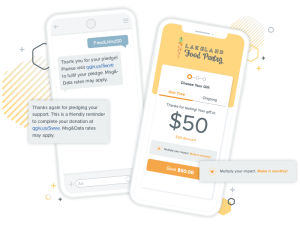If you’re a regular Qgiv blog reader, you know that I just participated in my first-ever peer-to-peer fundraiser. Fundraising just ended, and I wanted to share some strategies the fundraisers at the nonprofit used to keep us involved.
If you want some background on the event or past blog entries with more strategies, check out these articles:
- Diary of a Peer-to-Peer Fundraiser: How to Empower Participants
- Diary of a Peer-to-Peer Fundraiser: How to Get Your Participants Inspired
- Diary of a Peer-to-Peer Fundraiser: How to Start Fundraising
We spent a month fundraising before the big event. Here’s how the staff at Lakeland Volunteers in Medicine kept us involved the whole time!
They gave us a short time frame
A month might not sound like a short time frame, but it certainly seemed short! There were 20 participants in my fundraising group, and we’re all working professionals. A month was just the right amount of time to spend raising money. Making the fundraising period any shorter would have made me feel a bit frantic, and making it longer would have made fundraising feel like a slog.
Having four weeks to raise money, plan fundraising events, and make appeals to our family and friends played a huge role in keeping us involved in fundraising. Slacking off wasn’t an option!
What you can do
Spend some time considering how long you should ask your participants to stay involved. If your fundraising period is too short, fundraisers can feel as though there’s not enough time to do a good job. They may not even start at all! If your fundraising period is too long, it’s easy for participants to get complacent. Find your sweet spot! A good fundraising period will encourage people to get creative and plan fun fundraising activities without giving them a ton of room to put off raising money.
They created a sense of urgency
Our point person at Lakeland Volunteers in Medicine (Kathryn) regularly emailed participants about how much time we had left to raise money. If I recall correctly, we received encouraging emails:
- When the fundraising period officially started
- Halfway through the fundraising period
- At the beginning of the last week of fundraising
- The morning of the last day of fundraising
Each email followed a pretty predictable pattern. First, Kathryn opened each email with an enthusiastic “thank you!” to all the fundraisers for participating and for all the work we’d done so far. Then, she reminded us of how much longer we had to raise money. She’d include an encouraging note about what an amazing job we were all doing, then let us know that she was available if we had any questions.
These emails worked! I know for a fact that I made at least one (maybe two) appeals directly after Kathryn’s emails. My busy schedule means I often lose track of what the date (or day) is. The two-week mark definitely snuck up on me, and I was caught totally off guard by how quickly the window for fundraising closed.
What you can do
Keep in touch with your participants during their fundraising! Remember: you eat, sleep, and breathe fundraising. They don’t. They’re fitting fundraising for you into their busy schedules! Your participants will rely on you to remind them about important milestones, deadlines, and updates. Creating a sense of urgency will keep fundraising at the forefront of their minds and ensure they stay active during the fundraising period.
They made it super easy
Now, this part is going to be a little biased because I was using Qgiv’s peer-to-peer platform and, obviously, I work for Qgiv. Even if you’re not using Qgiv (which makes me sad, but I also understand), making it easy for your fundraisers to actually raise money is perhaps the most important step you can take.
We QA (in other words, we make updates and try to break stuff) our entire platform every two weeks, and I’ve gone through every conceivable function of our peer-to-peer platform a hundred times. But there is a HUGE difference between making sure a system works and actually using that system to raise money. Being on the “other side” of the Qgiv/fundraiser relationship was a little weird, but I managed. And, more importantly, the other participants—none of whom work for Qgiv—also managed. We more than managed—we thrived!
It was easy to set up our fundraising pages, to share our pages with our friends and family, and to track online and offline donations. At the fundraising event my husband and I ran at a local bar, we had my laptop set up so attendees could donate or buy raffle tickets. We also set up a last-minute text-to-donate keyword in our fundraising dashboard and got our first text donation less than 5 minutes later. It was so simple!
What you can do
Make it easy to raise money for you! If your fundraisers have to struggle to build their pages, spread the word, or take gifts, they just won’t engage at all. Remember, your participants are adding your fundraising activity to their already-busy lives. If they have to wrestle with your system to raise money, they’re going to get discouraged and burnt out… quickly.
If you worry that your participants are struggling with your system, you can try:
- Holding a participant event to teach them the system and get them excited. This could be fun! Spin it as a networking opportunity, a fundraising class, and a way to learn the system. If you focus exclusively on teaching people to use the system, you probably won’t get a lot of attendance. But if you add elements like networking, fundraising brainstorming, or socializing, more people will show up.
- Creating quick-start guides for participants. Whether you put together a simple infographic (like this one) or in-depth participant toolkits (like these examples from our clients), your participants will love having a resource on hand that will get them started. If you need help putting together a toolkit, we can help! We’ve got templates for participant and team captain toolkits; download them at the bottom of this article!
- Being a platform expert. If one of your participants calls for help, someone needs to be able to give them an answer! Make sure you and your staff know how to use the platform you’ve chosen. If you don’t know how to answer a question that comes up, be honest. Tell them you’re not sure! Then, find an answer or solution and follow up with your participant in a timely manner. If you’re a Qgiv client, you can always call us for help with questions you can’t answer!
Next up in the Diary of a Peer-to-Peer Fundraiser
Once we got through the fundraising period, it was time for us to actually participate in Lakeland Volunteers in Medicine’s event. We’ll go over how LVIM handled the transition, got the crowd hyped about fundraising, and gave the participants an experience we’ll never forget.
Want to see how Qgiv’s peer-to-peer platform works?
You can do that! Contact us online to get more information or schedule a one-on-one tour of our tools. You can also check out these other really great peer-to-peer event examples from our clients.








